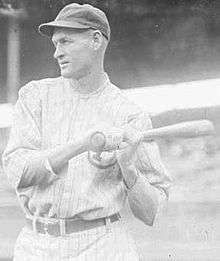Cy Williams
| Cy Williams | |||
|---|---|---|---|
 | |||
| Outfielder | |||
|
Born: December 21, 1887 Wadena, Indiana | |||
|
Died: April 23, 1974 (aged 86) Eagle River, Wisconsin | |||
| |||
| MLB debut | |||
| July 18, 1912, for the Chicago Cubs | |||
| Last MLB appearance | |||
| September 22, 1930, for the Philadelphia Phillies | |||
| MLB statistics | |||
| Batting average | .292 | ||
| Home runs | 251 | ||
| Runs batted in | 1,005 | ||
| Teams | |||
| Career highlights and awards | |||
| |||
Frederick "Cy" Williams (December 21, 1887 – April 23, 1974) was an American professional baseball player.[1] He played in Major League Baseball as an outfielder for the Chicago Cubs (1912–17) and Philadelphia Phillies (1918–30).[1] As Major League Baseball emerged from the dead ball era, Williams became one of the most prominent home run hitters in the National League.[2][3][4]
Baseball career
Born in Wadena, Indiana, Williams attended Notre Dame where he studied architecture and played football with Knute Rockne.[2] His hitting prowess caught the attention of the Chicago Cubs, who purchased his contract after he graduated from college.[2] Williams made his major league debut with the Cubs on July 18, 1912 at the age of 24.[1] From 1915 to 1927 he was a consistent power hitting center fielder, leading the National League in home runs four times during his career.[1] He is the only player other than Babe Ruth to lead a major league in home runs in both the dead-ball era and live-ball era (leading the National League with 12 and 15 home runs in 1916 and 1920, then with 41 and 30 in 1923 and 1927)
He was the first National League player to hit 200 career home runs, and is one of three players born before 1900 to hit 200 homers in his career (Babe Ruth and Rogers Hornsby are the others). He was the National League's career home run leader until his record of 251 was surpassed by Hornsby in 1929.[2]
The Williams Shift, in which defensive players moved to the right side of the playing field, is often associated with Ted Williams, but it was actually first employed against Cy Williams during the 1920s.[3][4] He played in his final major league game on September 22, 1930 at the age of 42.[1] In 1931, Williams served as a player-manager in the minor leagues for the Richmond Byrds of the Eastern League.[5]
Career statistics
In a nineteen-year major league career, Williams played in 2,002 games, accumulating 1,981 hits in 6,780 at bats for a .292 career batting average along with 251 home runs, 1,005 runs batted in and an on-base percentage of .365.[1] He hit over .300 six times in his career. An excellent defensive player, Williams had a .973 career fielding percentage, which was nine points higher than the league average during his playing career.[1]
Williams is the Phillies' all-time leader in extra-innings grand slams with two and holds the major league record for being the oldest player ever to win a home run title, hitting 30 home runs to win the National League home run title in 1927 at 39 years of age. Williams hit for the cycle on August 5, 1927.
Later life
After retirement he worked as an architect in Three Lakes, Wisconsin.[2] He died there at age 86 in 1974.
See also
- List of Major League Baseball career home run leaders
- List of Major League Baseball career runs scored leaders
- List of Major League Baseball career runs batted in leaders
- Hitting for the cycle
- List of Major League Baseball annual home run leaders
- Major League Baseball titles leaders
References
- 1 2 3 4 5 6 7 "Cy Williams statistics". Baseball-Reference.com. Retrieved 24 April 2012.
- 1 2 3 4 5 Cy Williams at the SABR Bio Project, by Cappy Gagnon, retrieved 24 April 2012
- 1 2 Vass, George (August 1999). 20th Century All-Overlooked Stars. Baseball Digest. Books.Google.com. Retrieved 24 April 2012.
- 1 2 Vass, George (July 2004). Baseball's Forgotten Stars. Baseball Digest. Books.Google.com. Retrieved 24 April 2012.
- ↑ "Cy Williams minor league statistics". Baseball-Reference.com. Retrieved 24 April 2012.
External links
- Career Statistics
- Cy Williams at the SABR Bio Project, by Cappy Gagnon, retrieved 24 April 2012
